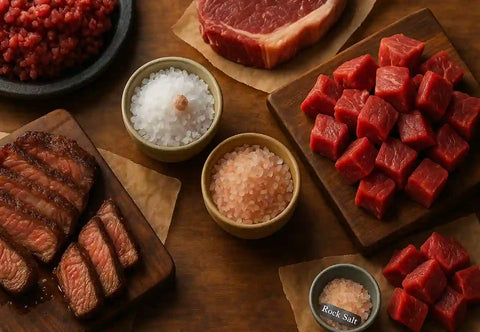Which Is Better for Meat: Sea Salt or Rock Salt?
Choosing the right salt makes all the difference in seasoning and creating the perfect sear. Learn the difference between sea salt and rock salt, and discover the best use for each: texture, solubility, seasoning, and timing for a perfectly juicy steak with a crisp crust.
Quick Summary:
- For a strong sear on steak: use coarse salt (sea or rock).
- For quick seasoning or after grilling: use fine salt.
- For dry brining: coarse sea/kosher salt 40–60 minutes (or overnight) before cooking.
- The key factor is grain size + timing, not the salt’s origin.
Common Types of Salt and When to Use Them
| Type | Texture | Best Use | Notes |
|---|---|---|---|
| Coarse Sea Salt | Large grains • Slight moisture | Steak sear, dry brining | Releases salt gradually, enhances sear |
| Coarse Rock Salt | Dry and purer | Strong sear, rubs for slow BBQ | Dissolves slower → better crust |
| Fine Sea/Rock Salt | Fine and fast dissolving | Quick seasoning, burger/kebab mixes | Use carefully to avoid over-salting |
| Kosher Salt | Flat, flaky grains | Dry brining, balanced seasoning | Easy to pinch and measure |
| Fleur de Sel | Flaky | Finishing salt after grilling | Delicate crunch, subtle mineral touch |
| Pink Himalayan | Fine/Coarse | General seasoning, finishing | Color is aesthetic; nutritional impact minimal |
What is Sea Salt?
Extracted by evaporating seawater; usually contains slight moisture and trace minerals. Available in fine or coarse textures. Larger grains distribute salt more gradually and help create a better sear.
What is Rock Salt?
Mined from ancient deposits; generally drier and purer than sea salt. Dissolves quickly when fine. Excellent for quick seasoning or as a finishing salt.








Comments (0)
There are no comments for this article. Be the first one to leave a message!